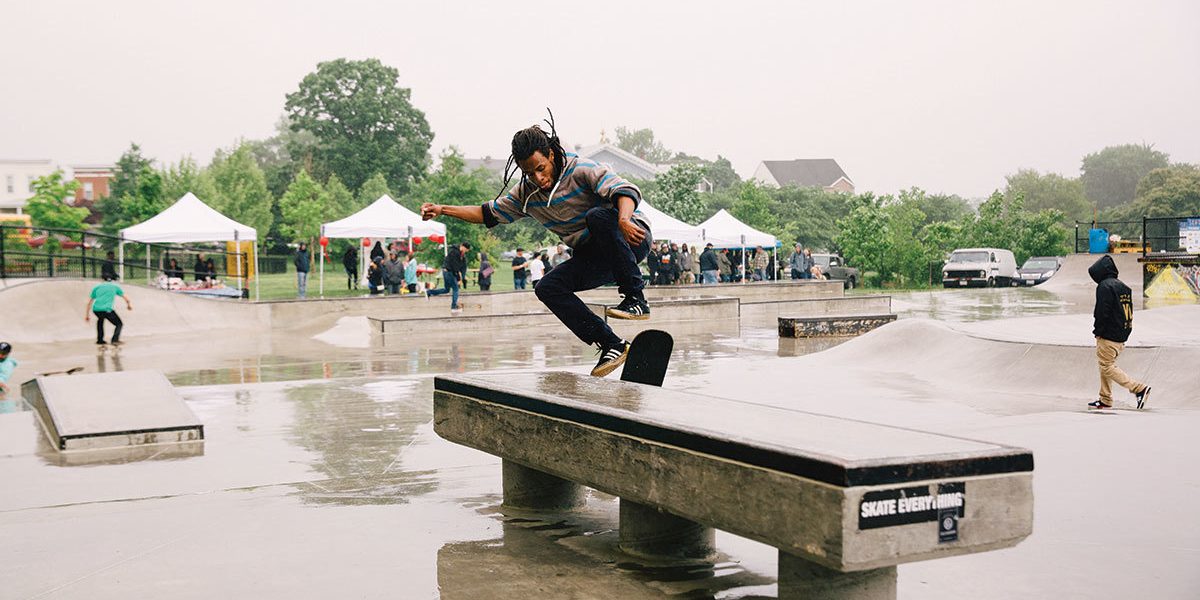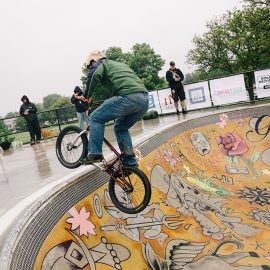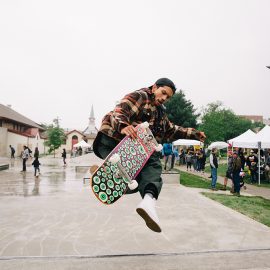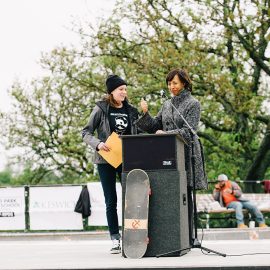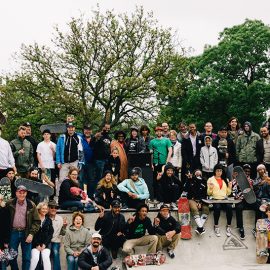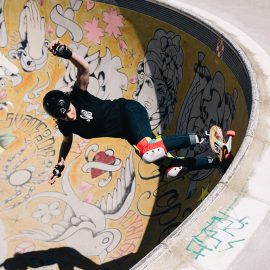News & Community
You Are Here: Concrete Kids
Scenes from the Roosevelt Park skate park, Mr. Trash Wheel's birthday, and Mt. Vernon Square.
Concrete Kids
May 13, 2017
West 36th Street
“Could I ask the elected officials here to raise their hands?” City Councilman Ryan Dorsey says, raising his own hand and glancing toward several fellow councilmen, a pair of state delegates, and Mayor Catherine Pugh, all in attendance this afternoon for the phase II grand opening of Hampden’s Roosevelt Park skate park. “Now, will everyone who has skated in this concrete bowl keep their hand up?”
The only hand still raised, of course, is that of youthful, 35-year-old Dorsey, who was elected to his first term last year.
Dorsey notes how long it took for the facility to get built—a dozen years—adding with a smile that he decided “it would be easier to run for office” than do the type of behind-the-scenes advocacy, organizing, and fundraising required to bring the 16,000-square-foot, world-class project to completion.
That said, the driving force behind the project works for one of Dorsey’s colleagues. Longtime skater Stephanie Murdock, also 35, serves as legislative director for Councilwoman Mary Pat Clarke. “It started when I placed an ad with my personal cellphone number in the back of the City Paper—next to all those ‘interesting’ ads—to gauge support and recruit volunteers,” Murdock recalls. “People began calling me who wanted a skate park.” She founded the nonprofit, 501(c)3 Skatepark of Baltimore in 2007.
In the past, says Northeast Baltimore native Spencer Brown, 28, skaters often jumped on the light rail, getting off near the University of Baltimore, Inner Harbor, or Meyerhoff Symphony Hall, looking for “a good place to grind” on ramps, stairs, ledges, boxes, and pipes.
“This brings in people from Maryland, D.C., Virginia, and Pennsylvania, and there are going to be professional teams coming in the next few weeks for competitions,” says Brown, who is sponsored by Hampden’s Vú Skate Shop and several other skateboard-oriented businesses. “The big thing is that the perception of skating, because of this project, has changed in recent years.
“There’s acceptance now.”
Table Scraps
May 15, 2017
Inner Harbor
Since 2014, Mr. Trash Wheel, the Inner Harbor’s water-and-solar-powered, garbage-devouring device, has pulled 1.1 million pounds of debris from the harbor—including nearly a half-million polystyrene containers, more than 650,000 snack and grocery bags, nearly 400,000 plastic bottles, and more than 9 million cigarette butts.
“He also gets a lot of baseballs and soccer balls, and random stuff, including beer koozies, a beer keg, a motorcycle helmet, pink flamingos—once a lost, 5-foot python,” says Cy Kellett, who helped build the prototype with his uncle John Kellett, Mr. Trash Wheel’s inventor.
Situated near where the Jones Falls flows into the Inner Harbor, the beloved Mr. Trash Wheel—a viral video showing him in action garnered nearly 1.5 million views, and he’s been profiled by the likes of CNN, NBC News, and National Geographic—is celebrating his birthday today. Along with staff from the Waterfront Partnership’s Healthy Harbor Initiative and a dozen or so local fans, the party this afternoon includes students from Commodore John Rodgers Elementary School, who have brought a “cake” (a used tire filled with plastic bottles and junk) to feed to Mr. Trash Wheel.
After the desserts are served, including actual cupcakes for the kids, Adam Lundquist, director of the Healthy Harbor Initiative, and Jonathan Jensen, on guitar and ukulele, respectively, lead the students and crowd in song. First there’s a rendition of “Happy Birthday” and then an homage to Mr. Trash Wheel, penned by Jensen, whose full-time job is as a bassist with the Baltimore Symphony Orchestra.
Scooping up the yutz and the cigarette butts
Up to 25 tons a day
Mr. Trash Wheel, Mr. Trash Wheel, Mr. Trash Wheel
He’s the hero of the harbor
“The world premiere of ‘Hero of the Harbor’ was last month at Peabody Heights Brewery,” Jensen grins. “For their launch of Mr. Trash Wheel’s Lost Python Ale.”
Statue of Liberty
May 16, 2017
North Charles Street
On May 17, 1917, nearly a century after the Marquis de Lafayette’s last visit to Baltimore, city leaders and a French delegation broke ground for a statue of the American Revolutionary War hero in Mount Vernon Square. The effort to memorialize the wildly popular Lafayette in Baltimore—a downtown city street had already been named in his honor—was meant to symbolize the important bond between the two countries as the U.S. entered World War I.
“Fifty-thousand residents of Baltimore turned out for the groundbreaking,” Robert Dalessandro, chairman of the U.S. World War I Centennial Commission, reminds a smaller but still enthusiastic crowd gathered in Mount Vernon Square to mark the 100th anniversary of the groundbreaking. Behind Dalessandro and the statue—and in front of Baltimore’s towering monument to George Washington—two 30-foot American and French flags blow in the wind.
Lafayette’s first visit to Baltimore came in 1781, when the dashing officer and his soldiers camped near here before heading further south. His second visit came in 1784 and his third in 1824, according to the Baltimore Sun, when the 67-year-old was greeted by celebratory cannon fire at Fort McHenry and a parade of ships.
It’s hard to overstate the courageous, freedom-fighting Lafayette’s hold on the American imagination, which continued long after his death. Dalessandro notes that when American troops first arrived in France in 1917, Col. C.E. Stanton, an aide to Gen. John J. Pershing, was said to have uttered: “Lafayette, we are here!”
After the ceremony, Michel Charbonnier, consul general of France at the French Embassy in Washington, is asked by an attendee about the French reaction to the election of President Donald Trump amid the administration’s early controversies.
“The French people have been interested in American politics for more than two centuries,” Charbonnier says with a diplomatic smile, alluding to Lafayette’s mission. “Not that we have always understood it.”
